Warning
You are looking at documentation for an older release. Not what you want? See the current release documentation.
You may create a personal calendar or group calendar that can be shared with specific users or groups to your desires. You can also create a calendar which is synchronized with a remote calendar.
Note
All personal calendars will be put in the Personal Calendars pane.
Click
 , then select Add Calendar from the drop-down menu.
, then select Add Calendar from the drop-down menu.
Fill in fields of the Details tab.
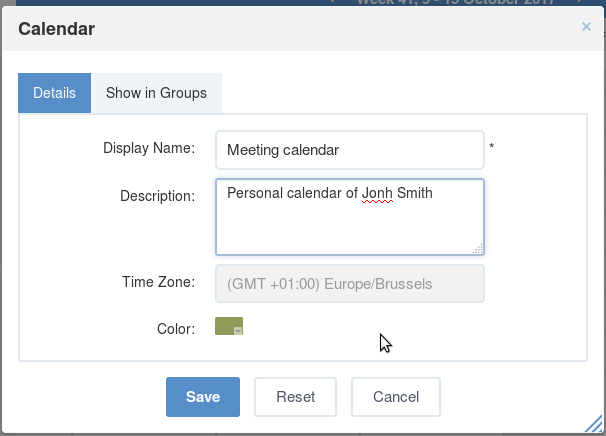
Details:
Field Description Display Name The calendar name which is displayed.
Description The brief description of the calendar. Time Zone The display time zone for the calendar activities which cannot be edited. However, you can change the time zone in your calendar settings.
Color The display color of the calendar activities that can be personalized.
Note
If you select the Show in Groups tab, then click
 to define specific groups and click
to define specific groups and click  , the calendar will be put in the Group Calendars category, not in the Personal Calendars category.
, the calendar will be put in the Group Calendars category, not in the Personal Calendars category.
Click Save to finish your creation.
Note
All group calendars will be put in the Group Calendars pane.
Follow steps as stated in Creating a personal calendar to give details for your new calendar.
Select the Show in Groups tab.

Select groups that contain your created calendar. The users of the selected groups can only view this calendar.
i. Click
 to open the Group Selector form.
This form will help you select a group that you want to share.
to open the Group Selector form.
This form will help you select a group that you want to share.
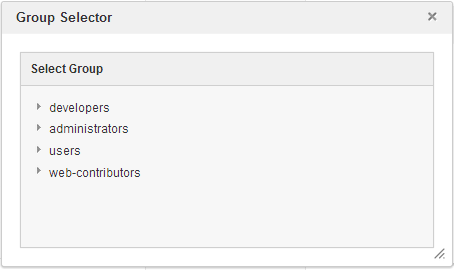
ii. Click your desired group, then select
 to add the defined group.
to add the defined group.
iii. Click
 or
or  to grant permissions to specific users or memberships respectively from the selected group.
to grant permissions to specific users or memberships respectively from the selected group.Note
If you set the * membership in the User able to edit calendar column, all users of the selected group will be able to edit this calendar, regardless of their membership role.
You can select more users/memberships by repeating the above steps. The selected users/memberships will be updated in corresponding textboxes.
You can delete your selected users/memberships manually in the textboxes or click
 to remove the permissions.
to remove the permissions.
Click to finish creating your new group calendar.
Note
To create a remote calendar in the Calendar application successfully, you need to learn about the calendar settings of the relevant provider. For more information about types of remote calendars, see here.
Click
 , then select Remote Calendar from the drop-down menu. The Subscribe Calendar form appears.
, then select Remote Calendar from the drop-down menu. The Subscribe Calendar form appears.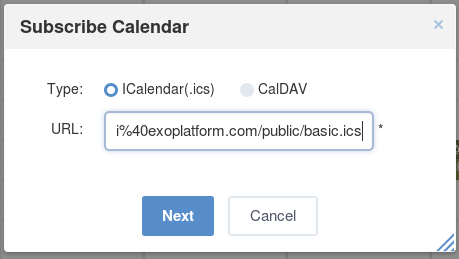
Select the type of the remote calendar: iCalendar or CalDAV.
Enter the URL linking to your calendar server in the URL field.
Click to go to the Remote Calendar form.

Fill in the fields. The asterisk (*) indicates the field is mandatory.
Tick the Use Authentication checkbox, then enter the username and password of your remote calendar server if the remote server requires verification.
Click to accept your creation.
Note
After creating a remote calendar, you can ONLY VIEW all events and tasks which are created in the remote calendar server right in
the Calendar application by clicking it. To get the updates, hover your cursor over the remote calendar, then click ![]() to select Refresh from the drop-down menu.
to select Refresh from the drop-down menu.
More information about types of remote calendars:
iCalendar:
iCalendar provides a link to an online .ics file from another calendar servers, such as Google Calendar, Yahoo Calendar, or eXo Calendar (including public URL or private URL).
An example of a Google Calendar URL (in iCal format):
CalDAV:
CalDAV is an open protocol that allows you to access calendars via WebDAV. With CalDAV, you can publish and subscribe to calendars, share them collaboratively, synchronize among multiple users or devices.
Google: https://apidata.googleusercontent.com/caldav/v2/calid/events where calid is the calendar id to be accessed.
Yahoo: https://caldav.calendar.yahoo.com/dav/your_yahoo_account@yahoo.com/Calendar/calendar_name/
How to import a Google calendar?:
Below an example of how to import a Google calendar to eXo Platform:
Go to your Google calender interface and select the calendar you wish to import to eXo Platform.
Click on options button
 of the chosen calendar and then select Settings and sharing.
of the chosen calendar and then select Settings and sharing.
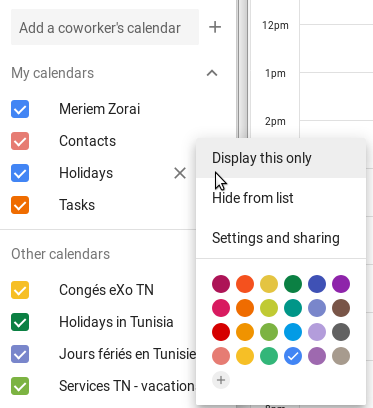
An interface Settings appears, scroll down to the section Integrate calendar and copy your calendar's public link in iCal format.
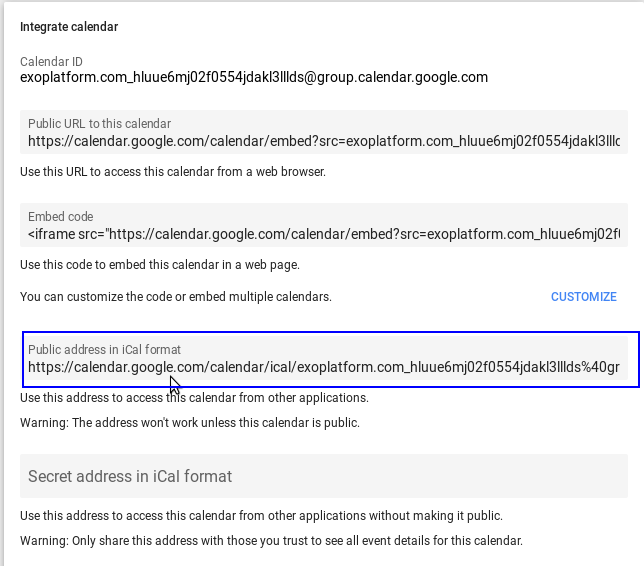
Go to the calendar interface in eXo Platform and click on the
 then on Remote calendar.
then on Remote calendar.Paste the iCal link to the field URL.
Click on to move to the form in calendar settings. Fill in the needed fields.
Note
If the imported remote calendar is not public, you should input your google account credentials in the "Authentication" section to enable the import procedure.